
Kiwifruit or Chinese gooseberry is the edible berry of several species of woody vines in the genus Actinidia. The most common cultivar group of kiwifruit is oval, about the size of a large hen's egg: 5–8 centimetres in length and 4.5–5.5 cm in diameter. It has a thin, fuzzy, fibrous, tart but edible light brown skin and light green or golden flesh with rows of tiny, black, edible seeds. The fruit has a soft texture with a sweet and unique flavour.

Actinidia is a genus of woody and, with a few exceptions, dioecious plants native to temperate eastern Asia, occurring throughout most of China, Taiwan, Korea, and Japan, and extending north to southern areas of Russian Far East and south into Indochina. The genus includes shrubs growing to 6 metres tall, and vigorous, strong-growing vines, growing up to 30 m (100 ft) in tree canopies. They mostly tolerate temperatures down to around −15 °C (5 °F), and some are much hardier.

Gooseberry is a common name for many species of Ribes, as well as a large number of plants of similar appearance. The berries of those in the genus Ribes are edible and may be green, orange, red, purple, yellow, white, or black.
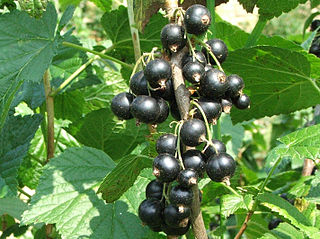
The blackcurrant, also known as black currant or cassis, is a deciduous shrub in the family Grossulariaceae grown for its edible berries. It is native to temperate parts of central and northern Europe and northern Asia, where it prefers damp fertile soils. It is widely cultivated both commercially and domestically.

Ribes is a genus of about 200 known species of flowering plants, most of them native to the temperate regions of the Northern Hemisphere. The various species are known as currants or gooseberries, and some are cultivated for their edible fruit or as ornamental plants. Ribes is the only genus in the family Grossulariaceae.

The redcurrant or red currant is a member of the genus Ribes in the gooseberry family. It is native to western Europe. The species is widely cultivated and has escaped into the wild in many regions.
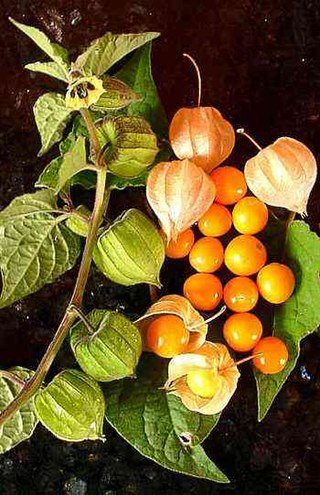
Physalis peruviana is a species of plant in the nightshade family (Solanaceae) native to Chile and Peru. Within that region, it is called aguaymanto, uvilla or uchuva, in addition to numerous indigenous and regional names. In English, its common names include Cape gooseberry, goldenberry and Peruvian groundcherry.

Ribes uva-crispa, known as gooseberry or European gooseberry, is a species of flowering shrub in the currant family, Grossulariaceae. It is native to Europe, the Caucasus and northern Africa. Gooseberry bushes produce an edible fruit and are grown on both a commercial and domestic basis. Its native distribution is unclear, since it may have escaped from cultivation and become naturalized. For example, in Britain, some sources consider it to be a native, others to be an introduction. The species is also occasionally naturalized in scattered locations in North America.

Actinidia arguta, the hardy kiwi, is a perennial vine native to Japan, Korea, Northern China, and the Russian Far East. It produces a small kiwifruit without the hair-like fiber covering the outside, unlike most other species of the genus.

Actinidia deliciosa, the fuzzy kiwifruit, is a fruiting vine native to Southern China. Other species of Actinidia are also found in China and range east to Japan and north into southern areas of Russian Far East. This species grows naturally at altitudes between 600 and 2,000 m.

The jostaberry is a complex-cross fruit bush in the genus Ribes, involving three original species, the blackcurrant R. nigrum, the North American coastal black gooseberry R. divaricatum, and the European gooseberry R. uva-crispa. It is similar to Ribes × culverwellii, the jochelbeere, which is descended from just two of these species, R. nigrum and R. uva-crispa.

Ribes menziesii, the canyon gooseberry, is a species of currant found only in California and Oregon. There are five to six varieties of the species found across the low elevation mountains of California, especially the Coast Ranges, and the coastal canyons and foothills, into southern Oregon. It can be found in the chaparral plant community.
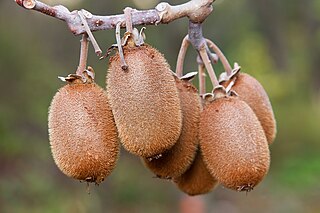
Actinidia chinensis(Planch.), known commercially as the golden kiwifruit, is a fruiting vine, native to China. It is one of some 40 related species of the genus Actinidia, and closely related to Actinidia deliciosa, which is the source of the most common commercial kiwifruit. Fruit colour may vary from green to lime green or gold, depending on breeding.
Gooseberry most often refers to a cultivated plant from two species of the genus Ribes:

Ribes divaricatum is a species in the genus Ribes found in the forests, woodlands, and coastal scrub of western North America from British Columbia to California. The three accepted varieties have various common names which include the word "gooseberry". Other common names include coast black gooseberry, wild gooseberry, Worcesterberry, or spreading-branched gooseberry.

Ribes inerme is a species of currant known by the common names whitestem gooseberry and white stemmed gooseberry. It is native to western North America from British Columbia to California and eastward to the Rocky Mountains. It grows in mountain forests, woodlands, and meadows.
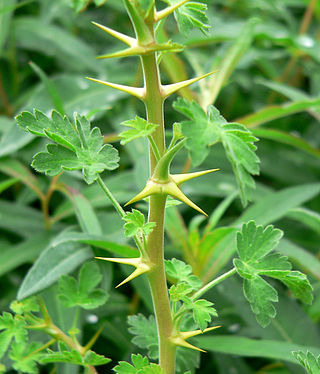
Ribes montigenum is a species of currant known by the common names mountain gooseberry, alpine prickly currant, western prickly gooseberry, and gooseberry currant. It is native to western North America from Washington south to California and east as far as the Rocky Mountains, where it grows in high mountain habitat types in subalpine and alpine climates, such as forests and talus. It is a spreading shrub growing up to 1.5 meters tall, the branching stems covered in prickles and hairs and bearing 1 to 5 sharp spines at intervals.

Ribes thacherianum, with the common name Santa Cruz gooseberry, or Santa Cruz Island gooseberry, is a rare North American species of currant found only on one island off the coast of California.

Ribes hirtellum is a species of gooseberry commonly known as wild gooseberry or swamp gooseberry. It is native to Canada and the northern United States. Cultivated gooseberries are derived from this species and from Ribes uva-crispa.
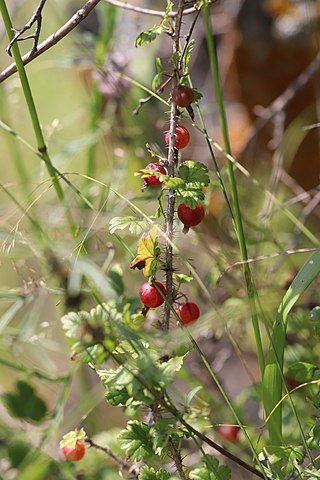
Ribes aciculare is a species of flowering plant in the currant/gooseberry family Grossulariacea, generally regarded as closely related to Ribes burejense. It is native to central and northern Asia, and has been reported as native to Altay, Kazakhstan, Krasnoyarsk, Mongolia, Tuva, West Siberia, Xinjiang. Its habitats vary from stony hill and mountain slopes to forest margins and thickets. In Northern China it has been found at altitudes of 1,500-2,100 metres. The plant is very cold hardy, and can tolerate temperatures down to -20°C during dormancy.



















